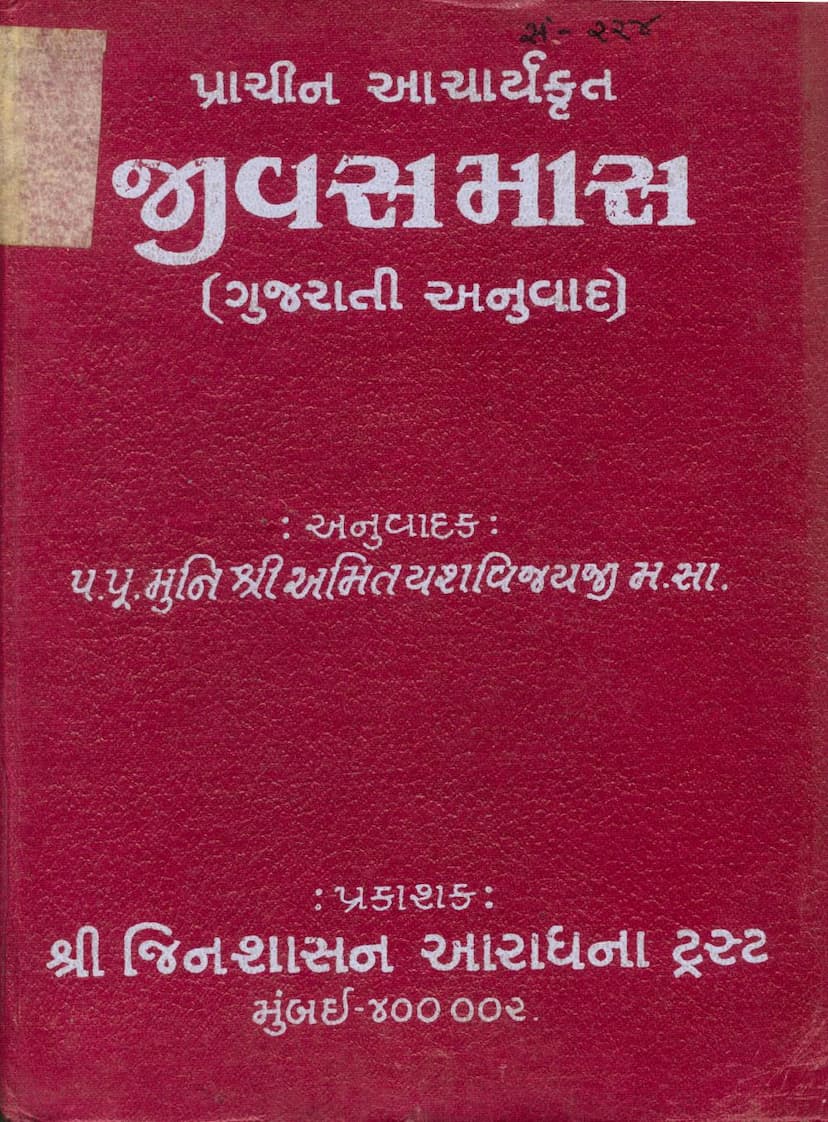Jivsamas
Added to library: September 2, 2025

Summary
This Jain text, "Jivsamas" by Acharya Amityashsuri, translated into Gujarati by Muni Amitayash Vijayji Maharaj and published by Shri Jinshasan Aradhana Trust, is a profound work of Jain philosophy. It delves into the nature and classification of souls (Jiva) within the framework of Jainism.
Here's a comprehensive summary of the provided text:
Core Subject Matter:
The "Jivsamas" (also known as "Jiva Samasa") is a foundational text in Jainism that systematically classifies and explains the various types of souls (Jivas) based on their attributes, stages of spiritual development, sensory perception, life-forms, and transmigration. The text aims to provide a comprehensive understanding of the soul's journey through different states of existence.
Key Concepts and Structure:
The book is structured into several "Samasa" (sections or classifications), each focusing on a specific aspect of the Jiva:
- Granthapithika (Introduction): This section likely introduces the purpose and scope of the work, perhaps highlighting the importance of understanding Jivas for spiritual liberation.
- Dravya Samasa (Substance Classification): This section deals with the fundamental categories of existence, likely covering Jiva (soul) and Ajiva (non-soul) as the two primary substances in Jainism. It would detail their inherent qualities and characteristics.
- Kshetra Samasa (Location/Region Classification): This section would explore the spatial distribution of souls, including their presence in different realms and environments of the Jain cosmology.
- Kala Samasa (Time Classification): This would delve into the temporal aspects of the soul's existence, including lifespan, transmigration cycles, and the influence of time on the soul's state.
- Bhava Samasa (State/Disposition Classification): This is a crucial section focusing on the different spiritual states or dispositions (Bhavas) that souls pass through, ranging from the most deluded (mithyatva) to the most liberated (siddha). This likely includes the discussion of various Gunasthanas (spiritual stages).
- Antara Samasa (Interval Classification): This section would discuss the intervals or gaps between different states of existence or spiritual stages, likely focusing on the time that elapses before a soul can attain a different state or progress further.
- Veda Kashaya Samasa (Sexuality and Passions Classification): This would classify souls based on their experience of sexuality (Veda) and the nature of their passions or afflictions (Kashaya), which are crucial in understanding karmic bondage.
- Jnana Samasa (Knowledge Classification): This section would detail the different types of knowledge (Jnana) that souls possess, ranging from sensory knowledge (Mati) to perfect omniscience (Kevala).
- Sanyama Samasa (Restraint/Discipline Classification): This would focus on the practice of restraint and discipline, crucial for spiritual progress in Jainism, and how souls at different stages engage with or deviate from it.
- Darshana Samasa (Perception Classification): This section would likely discuss the different modes of perception (Darshana) available to souls, from the lowest (Avadhi) to the highest (Keval).
- Leshya Samasa (Color/Disposition Classification): This section would classify souls based on their subtle psychical colorations or dispositions (Leshya), which are believed to be influenced by their thoughts and actions.
- Bhavyadvara (Auspiciousness/Potentiality): This likely discusses the concept of "Bhavya" (soul capable of liberation) and "Abhavya" (soul incapable of liberation), a significant tenet in Jain philosophy.
- Aharaka-Anaharaka Samasa (Nourishment Classification): This section would address souls that are capable of taking nourishment (Aharaka) and those that are not (Anaharaka).
- Alpabahutva Samasa (Minority/Majority Classification): This section would compare the numbers of souls in different categories, establishing their relative magnitudes.
- Upasamharadvara (Conclusion): This concluding section would likely summarize the teachings and perhaps offer final blessings or exhortations.
Key Themes and Philosophical Underpinnings:
- Karma Theory: The entire classification is deeply rooted in the Jain concept of Karma. The state of a soul (Jiva) and its attributes are determined by the types of karmas it has accumulated and its current spiritual stage.
- Ahimsa (Non-violence): Jainism places immense emphasis on Ahimsa. The detailed classification of souls, including even the subtlest forms of life like microorganisms and plants (Ekendriya), highlights the Jain commitment to non-violence towards all living beings.
- Spiritual Progress: The stages of spiritual development (Gunasthanas) are central to understanding the soul's journey. "Jivsamas" would likely elaborate on how souls progress or regress through these stages based on their actions and dispositions.
- Metaphysics and Ontology: The text engages with fundamental metaphysical questions about the nature of reality, the soul, its existence, and its relationship with the non-soul substances.
- Saptatva (Seven Truths): While not explicitly mentioned as a section, the foundational principles of Jainism, the Saptatvas (Jiva, Ajiva, Asrava, Bandha, Samvara, Nirjara, Moksha), likely underpin the classifications discussed.
Translator and Publisher:
- Translator: P.P. Muni Shri Amitayash Vijayji Maharaj
- Publisher: Shri Jinshasan Aradhana Trust, Mumbai
Overall Significance:
"Jivsamas" is essential for Jain scholars and practitioners to grasp the intricate details of the soul's existence and the path to liberation. It serves as a comprehensive guide to understanding the multifaceted nature of the Jiva, which is the central focus of Jain spiritual practice. The Gujarati translation makes this complex philosophical treatise accessible to a wider audience. The text emphasizes the Jain worldview that classifies all beings, from the most complex to the seemingly simplest, based on their spiritual potential and karmic bondage.